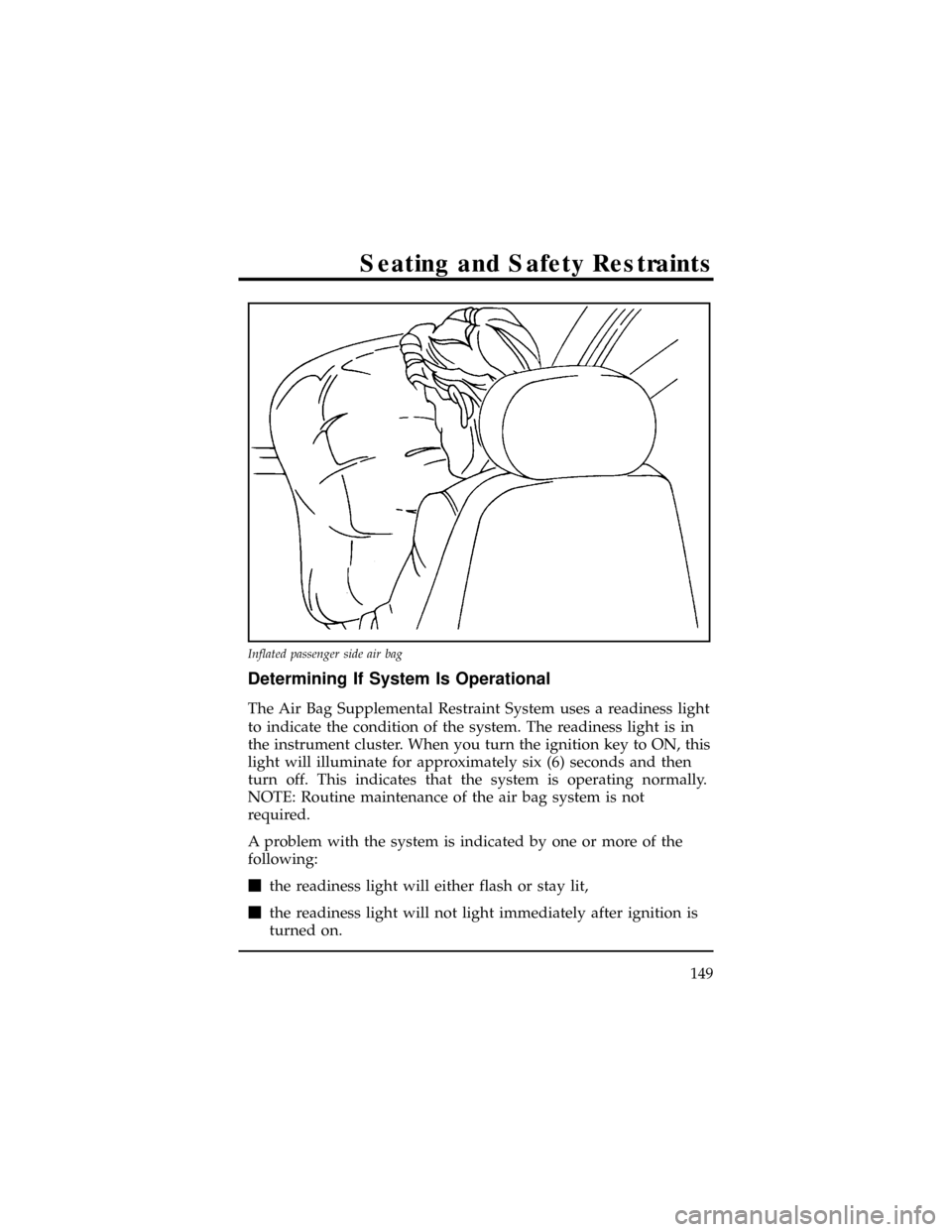maintenance Mercury Villager 1998 Owner's Manuals
[x] Cancel search | Manufacturer: MERCURY, Model Year: 1998, Model line: Villager, Model: Mercury Villager 1998Pages: 400, PDF Size: 2.06 MB
Page 3 of 400

Table of Contents
Introduction...................1
Instrumentation.................7
Electronic Sound Systems.............29
Controls and Features...............53
Seating and Safety Restraints............121
Adjustable Rear Seating..............177
Starting....................207
Driving....................215
Roadside Emergencies..............241
Maintenance and Care..............275
Capacities and Specifications............337
Reporting Safety Defects.............343
Customer Assistance...............345
Accessories..................355
Quick Index..................363
Index.....................373
Service Station Information............400
Page 7 of 400

TheQuick Indexat the end of the book provides a page number
following each item which indicates where detailed
information can be found.
To use theIndex, turn to the back of the book and search in the
alphabetical listing for the word that best describes the
information you need. If the word you choose is not listed, think
of other related words and look them up. We have designed
the Index so that you can find information under a technical term.
Canadian Owners Ð French Version
French Owner Guides can be obtained from your dealer or by
writing to Ford Motor Company of Canada, Limited, Service
Publications, P.O. Box 1580, Station B, Mississauga, Ontario
L4Y 4G3.
Maintenance Schedule
As with any other member of your family, your new vehicle
requires routine care and regular check-ups. A separateMaintenance
Schedulebooklet is included to help you keep track of all
services performed and summarizes the day-to-day services that
are most important for keeping your vehicle in good
condition.
Warranties
Your vehicle is covered by three types of warranties:Basic
Vehicle Warranty,Extended Warrantieson certain parts, and
Emissions Warranties.
Read yourWarranty Guidecarefully to find out about
your vehicle's warranties and your basic rights and
responsibilities.
Introduction
3
Page 8 of 400

If you lose yourWarranty Guide,you can get a new one free of
charge. Contact any Ford or Lincoln-Mercury dealer, or refer to the
addresses and phone numbers on the first page of this Owner's
Guide.
Ford's Extended Service Plan (ESP)
More Protection for Your Vehicle
You can get more protection for your new car or light truck by
purchasing a Ford Extended Service Plan (Ford ESP). Ford ESP is
the only extended service program with the Ford name on it
and the only service contract backed by Ford Motor Company.
Ford ESP is an optional service contract, backed and administered
by Ford. It provides:
mprotection against repair costs after your Bumper to Bumper
Warranty expires;
and
mother benefits during the warranty period (such as:
reimbursement for rentals; coverage for certain maintenance
and wear items).
You may purchase Ford ESP from any participating Ford or
Lincoln-Mercury Motor Company dealer. There are several Ford
ESP plans available in various time-and-mileage
combinations. Each plan can be tailored to fit your own driving
needs, including reimbursement benefits for towing and
rental. (In Hawaii, rules vary. See your dealer for details.)
When you purchase Ford ESP, you receive peace-of-mind
protection throughout the United States and Canada, provided by
a network of more than 5,100 participating Ford Motor
Company dealers.
NOTE: Repairs performed outside the United States and
Canada are not eligible for ESP coverage.
4
Page 23 of 400

Under any circumstances, if the pointer moves past the upper
limit of the NORMAL band, the engine is overheating and engine
damage may occur.
If your engine overheats:
1. Pull off the road as soon as it is safely possible.
2. Turn off the engine. If you do not stop the engine as soon as
safely possible, severe engine damage could result.
3. Let the engine cool.DO NOT REMOVE COOLANT SYSTEM
FILL CAP UNTIL THE ENGINE IS COOL.
4. Check the coolant level following the instructions on checking
and adding coolant to your engine, seeEngine coolantin the
Index. If you do not follow these instructions, you or others
could be injured.
5. Refer toAdding Engine Coolantin theMaintenance and Care
chapter. Add as much coolant as your engine needs. If the engine
continues to overheat, have the cooling system serviced.
Speedometer
The speedometer tells you how many miles (kilometers) per hour
your vehicle is moving.
Engine coolant temperature gauge
Instrumentation
19
Page 148 of 400

Safety Belt Maintenance
Check the safety belt systems periodically to make sure that they
work properly and are not damaged.
All safety belt assemblies, including retractors, buckles, front seat
belt buckle support assemblies (slide bar) (if so equipped),
child safety seat tether bracket assemblies (if so equipped), and
attaching hardware, should be inspected after any collision. Ford
recommends that all safety belt assemblies used in vehicles
involved in a collision be replaced. However, if the collision was
minor and a qualified technician finds that the belts do not
show damage and continue to operate properly, they do not need
to be replaced. Safety belt assemblies not in use during a
collision should also be inspected and replaced if either damage
or improper operation is noted.
Air Bag Supplemental Restraint System
(SRS)
Important Air Bag Precautions
Your vehicle is equipped with a supplemental restraint system
designed to work with the safety belts to help protect you and your
right front seat passenger in the event of certain collisions
described in the sectionHow Does the Air Bag Supplemental Restraint
System Work?
WARNING
All occupants of the vehicle, including the driver, should
always wear their safety belts.
144
Page 153 of 400

Determining If System Is Operational
The Air Bag Supplemental Restraint System uses a readiness light
to indicate the condition of the system. The readiness light is in
the instrument cluster. When you turn the ignition key to ON, this
light will illuminate for approximately six (6) seconds and then
turn off. This indicates that the system is operating normally.
NOTE: Routine maintenance of the air bag system is not
required.
A problem with the system is indicated by one or more of the
following:
mthe readiness light will either flash or stay lit,
mthe readiness light will not light immediately after ignition is
turned on.
Inflated passenger side air bag
Seating and Safety Restraints
149
Page 240 of 400

Trailer Tow Module (If equipped)
The trailer tow module on your vehicle (if equipped) allows
turn/stop lamp control on a trailer being towed by your vehicle.
The trailer tow package includes:
mtrailer tow module which is protected by the vehicle stop
lamp fuse
mone SAE J1239 specified connector
mone extension harness within the rear bumper
mheavy duty battery
mfull size spare
If you need further assistance in wiring a trailer to your vehicle,
contact your Ford or Lincoln-Mercury dealer.
Driving While You Tow
Be especially careful when driving while you tow a trailer. Never
drive faster than 45 mph (70 km/h) when you tow in hilly
country on hot days. Also, anticipate stops so that you can brake
gradually.
If you use the speed control while you are towing on very long,
steep grades, the speed control may shut off automatically.
This is caused by the decrease of vehicle speed 5 mph (8 km/h)
lower than set speed.
When descending a steep grade with a trailer, operate in Drive
rather than Overdrive. If additional braking is needed, shift into 2
(Second) or 1 (First) gear.
Servicing Your Vehicle If You Tow
If you tow a trailer for a long distance, your vehicle will need to
be serviced more frequently than usual. See theMaintenance
Schedulebooklet in the Owner's portfolio.
236
Page 276 of 400

Jump-Starting
1. Make sure that the jumper cables are not in the way of
moving engine parts, then start the booster vehicle. Run the
engine at a moderate speed.
2. Let the discharged battery charge for a few minutes and then
start the disabled vehicle. It may take a couple of tries before
the vehicle starts. If the vehicle does not start after several
attempts, there may be a different problem.
3. When both vehicles are running, let them idle for a few
minutes to charge the discharged battery.
Removing jumper cables
1.Always remove the jumper cables in the reverse order.
Remove the negative (±) end of the jumper cable from the
metallic surface on the engine or frame of the disabled
vehicle.
2. Remove the negative (±) cable from the booster battery.
3. Remove the positive (+) cable from the booster battery.
4. Remove the other end of the positive (+) cable from the
discharged battery.
If you need to replace your battery, seeBatteryin theMaintenance
and Carechapter.
Towing Your Vehicle
If you need to have your vehicle towed, contact a professional
towing service or, if you are a member, your roadside assistance
center.
DO NOT TOW YOUR VILLAGER WITH SLINGBELT
EQUIPMENT. Ford Motor Company has not developed or
approved a T-hook sling-type procedure. Use wheel lift or flatbed
equipment.
272
Page 279 of 400

Service Made Easy
Ford has two goals for servicing your vehicle.
1. When we can, we design parts that do not need to be
serviced.
2. We want to make servicing your vehicle as easy as possible.
To help you:
mWe highlight do-it-yourself items in yellow in your engine
compartment so that you can find them easily.
mWhen possible, we design parts that can be replaced without
tools.
mWe give you a Maintenance Schedule that makes tracking
routine service for your vehicle easy. TheMaintenance
Schedulebooklet is part of your owners portfolio.
This chapter tells you about the basic parts that you need to
check and service regularly.
If your vehicle needs professional servicing, your dealership can
provide the parts and service required. Check yourWarranty Guide
to find out which parts and services are covered. Also see the
Customer Assistancechapter of this Owner's Manual.
Ford Motor Company recommends that the Owner Maintenance
Checks listed in theMaintenance Schedulebooklet be
performed for the proper operation of your vehicle. In addition
to the conditions listed in the Owner Maintenance Checklist, be
alert for any unusual noise, vibration, or other indication that
your vehicle may need service. If you do notice something unusual,
see that your vehicle is serviced promptly.
Use only recommended fuels, lubricants, fluids, and service parts
that meet Ford Motor Company specifications. Motorcraft
parts are designed and built to provide the best performance in
your vehicle.
Maintenance and Care
275
Page 281 of 400

If you must work under the hood while the engine is running:
mSet the parking brake fully and make sure that the gearshift
is securely latched in P (Park). This will prevent your
vehicle from moving unexpectedly.
WARNING
Do not start your engine with the air cleaner removed and
do not remove it while the engine is running.
mAvoid wearing loose clothing or jewelry that could get caught
in moving parts. Take appropriate precautions with long hair.
Opening the Hood
1. Pull the hood release handle, located below the fuse panel
door.
Hood release handle location
Maintenance and Care
277